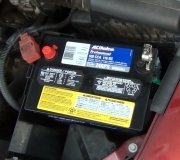Battery drain solved!
(long answer, but comprehensive and worth the read)
Just fixed this problem on my neighbor’s truck! Prior to isolating the problem, I read multiple forums and chased the same directions everyone else did (battery, alternator, current draw, intermittent shorts, belt) without success. Battery drain was not the problem.
Those amperage draws you mentioned are insignificant. Those are both "keep alive" circuits for computer memory (anti-theft, radio, key-less entry, etc.) Somewhere on the truck. Car batteries are typically rated around 70 amp/hours. That means your drainage would still allow the battery to function for over 1000 hours, or 45 days, not randomly drain overnight.
Math: 70 amp/hour battery/.065 amp drain = 1076 hours = 44.8 days
Problem with solution below
When copper gets a gradual patina, the outside turns dark to protect the metal underneath. Think of an old penny or an unprotected copper air condition line looks outside your home. That darkened surface is oxidization/corrosion and makes it less capable to conduct current. This is where the problem resides. Oxidation can and will seep into any gaps, regardless of how thin they are. Tightly secured contacts won’t prevent the corrosion/oxidization from forming between electrical mating surfaces.
Physics: as the oxidation increases on mating surfaces, the ability for that surface to carry current (amps) decreases. The limited area of good contact has to now carry the same current. The same current going thru a smaller area makes that area get hot. Extra heat results in additional oxidization, which results in less conductive area, which keeps getting worse until you end up reading a reply like this one.
1st sign of success: I removed and recharged the battery in my garage. Before reinstalling it back into the truck, I cleaned the terminal leads with a copper (?) Brush. Immediately the truck worked for great for several days before the problem gradually came back.
2nd sign: after removing and recharging the battery again, I dug a bit deeper on the truck before reinstalling it. I cleaned the terminal leads with a proper battery brush. I also decided to separate the plates that bolt to the positive battery terminal. I was surprised to see the gaps between the plates were nearly black. It was raining so I quickly half-assed cleaned the plates with a copper brush and reassembled. The truck started and ran for several weeks without any problems. Even the weird intermittent electrical problems (ac working then cutting out, power windows very slow, electric locks inoperable, interior and headlights dim, horn barely honking when locking the car) were basically gone. After sitting for a several more weeks with zero use, my neighbor told me the truck wouldn't start. When I went to check it out, there were some big differences. The remote unlocked (barely) the doors, the interior lights were dim but present, and the starter clicked. The battery had died from lack of use and from the owner occasionally starting it without driving it or letting it run for enough time to recharge the battery. I removed the battery again and bought it home to charge.
The eureka moment: because I had a major improvement from partially cleaning reassembling the positive terminal plates in the rain the last time, I figured the oxidization had gradually found its way back between the plates. Upon disassembling them, I was right. Well, I was prepared this time with sandpaper, a vinegar/baking soda cleaning solution, and a corrosion preventative compound. I also had all of the tools to check out the other connections.
I disassembled and found significant copper patina/oxidation on the following surfaces:
� negative battery lead terminal
i cleaned this with sandpaper until it was bright and shiny
� where the negative terminal lead connects to the body of the truck
the conductive lead on the negative terminal lead had clearly degraded over the
years. It wasn’t coppery and had the same black patina. I again used sandpaper to
make it bright and shiny.
Where that terminal lead connects to the body was also degraded. I could see that
there was barely any bare body metal exposed. Again, I made it bright and shiny.
� where the negative terminal lead attaches to the engine block
again, this tightly connected surfaces showed the same darkened patina.
Sandpaper made everything right.
� between the plates on the positive terminal leads
as I suspected, the patina was working its way back onto the plate surfaces.
Sandpaper worked way better than the copper brush in making the plate
surfaces bright and shiny.
Finally, I put a dielectric grease on all of the mating surfaces before reassembling them, skipping the engine block terminal because it would quickly melt away. Keep in mind, none of these surfaces had any protectant from the factory. Anyway, the truck now starts (quickly, not churning) and all of the accessories function factory new since I performed this process. I hope this helps anyone unfortunate enough to have had their butt kicked by chasing this problem. It took me about 2.5 hours from start to finish. I would love to know if this helps someone out.
Addition: I had a friend with very similar problems on his 2006 Toyota highlander. It would run great for a few days, then randomly not start. Sometimes that would happen when leaving a store, or trying to start the car after sitting overnight. He had already changed his battery and his alternator tested out good. I told him about what I had found on the Nissan and recommended he check out the same possibility. He found the same blackening between the positive terminal plates, but the other mating surfaces were in good shape. After cleaning the plates, his problem is gone.
Wednesday, November 11th, 2020 AT 11:08 AM

